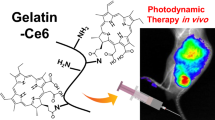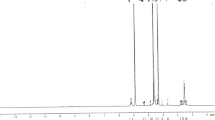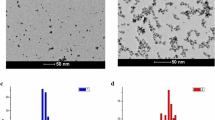Abstract
Recent advances in drug carrier design in the field of photodynamic therapy (PDT) have stimulated the development of numerous sophisticated drug delivery carriers. We developed novel biodegradable and biocompatible nanogels as PDT carriers. The nanogels were synthesized by ATRP technique using inverse miniemulsion and their biodegradability was determined in the presence of glutathione. The model photosensitizer (PS) was encapsulated in the biodegradable nanogels by simple mixing and sonication. The cellular uptake of the PS-loaded nanogels and the cytotoxicity of the nanogels before and after laser irradiation were determined using HeLa cells. The results showed that the Ce6-nanogel complex was well internalized into the tumor cells, and the Ce6-loaded nanogels did not influence on cellular viability of the cells before light irradiation. Under light exposure, however, the Ce6-nanogel complex-treated HeLa cells revealed strong photoactivity. These nanogels may enhance therapeutic efficacy of PSs without any complex chemical modifications with PSs.









Similar content being viewed by others
References
Wang SZ, Gao RM, Zhou FM, Selke M (2004) Nanomaterials and singlet oxygen photosensitizers: potential applications in photodynamic therapy. J Mater Chem 14:487–493
Jang B, Park JY, Tung CH, Kim IH, Choi Y (2011) Gold nanorod-photosensitizer complex for near-infrared fluorescence imaging and photodynamic/photothermal therapy in vivo. ACS Nano 5(2):1086–1094
Chatterjee DK, Fong LS, Zhang Y (2008) Nanoparticles in photodynamic therapy: an emerging paradigm. Adv Drug Deliv Rev 60(15):1627–1637
Celli JP, Spring BQ, Rizvi I et al (2010) Imaging and photodynamic therapy: mechanisms, monitoring, and optimization. Chem Rev 110(5):2795–2838
DeRosa MC, Crutchley RJ (2002) Photosensitized singlet oxygen and its applications. Coord Chem Rev 233–234:351–371
Triesscheijin M, Baas P, Schellens JH, Stewart FA (2006) Photodynamic therapy in oncology. Oncologist 11(9):1034–1044
Lee DJ, Youn YS, Lee ES (2015) Photodynamic tumor therapy of nanoparticles with chlorin e6 sown in poly(ethylene glycol) forester. J Mater Chem B 3:4690–4697
Lam KS, Li YP, Lin TY et al (2013) Novel multifunctional nanocarriers for drug delivery, photodynamic therapy, sonodynamic therapy, MRI and PET imaging. Cancer Res 73:4508
Konan YN, Gurny R, Allemann E (2002) State of the art in the delivery of photosensitizers for photodynamic therapy. J Photochem Photobiol 66(2):89–106
Huang X, EI-Sayed IH, Qian W, EI-Sayed MA (2006) Cancer cell imaging and photothermal therapy in the near-infrared region by using gold nanorods. J Am Chem Soc 128(6):2115–2120
Peer D, Karp JM, Hong S, FaroKHzad OC, Margalit R, Langer R (2007) Nanocarriers as an emerging platform for cancer therapy. Nat Nanotechnol 12:751–760
Chacko RT, Ventura J, Zhuang JM, Thayumanavan S (2012) Polymer nanogels: a versatile nanoscopic drug delivery platform. Adv Drug Deliv Rev 64(9):836–851
Meng FH, Hennink WE, Zhong Z (2009) Reduction-sensitive polymers and bioconjugates for biomedical applications. Biomaterials 30(12):2180–2198
Zhang Q, Ko NR, Oh JK (2012) Recent advances in stimuli-responsive degradable block copolymer micelles: synthesis and controlled drug delivery applications. Chem Commun 48(61):7542–7552
Oh JK, Siegwart DJ, Lee H-I et al (2007) Biodegradable nanogels prepared by atom transfer radical polymerization as potential drug delivery carriers: synthesis, biodegradation, in vitro release, and bioconjugation. J Am Chem Soc 129(18):5939–5945
Oh JK, Tang C, Gao H, Tsarevsky NV, Matyjaszewaki K (2006) Inverse miniemulsion ATRP: a new method for synthesis and functionalization of well-defined water-soluble/cross-linked polymeric particles. J Am Chem Soc 128(16):5578–5584
Hawker CJ, Wooley KL (2005) The convergence of synthetic organic and polymer chemistries. Science 309(5738):1200–1205
Gao HF, Louche G, Sumerlin BS, Jahed N, Golas P, Matyjaszewaki K (2005) Gradient polymer elution chromatographic analysis of α, ω-dihydroxypolystyrene synthesized via ATRP and click chemistry. Macromolecules 38(22):8979–8982
Lutz JF, Borner HG, Weichenhan K (2006) Combining ATRP and “click” chemistry: a promising platform toward functional biocompatible polymers and polymer bioconjugates. Macromolecules 399(19):6376–6383
Eichenbaum KD, Thomas AA, Eichenbaum GM, Gibney BR, Needham D, Kiser PF (2005) Oligo-α-hydroxy ester cross-linkers: impact of cross-linker structure on biodegradable hydrogel networks. Macromolecules 38(26):10757–10762
Huang X, Lowe TL (2005) Biodegradable thermoresponsive hydrogels for aqueous encapsulation and controlled release of hydrophilic model drugs. Biomacromolecules 6(4):2131–2139
Seymour LW, Duncan R, Strohalm J, Kopecek J (1987) Effect of molecular weight (M w ) of N-(2-hydroxypropyl)methacrylamide copolymers on body distribution and rate of excretion after subcutaneous, intraperitoneal, and intravenous administration to rats. J Biomed Mater Res 21(11):1341–1358
Tsarevsky NV, Sarbu T, Goebelt B, Matyjaszewski K (2002) Synthesis of styrene-acrylonitrile copolymers and related block copolymers by atom transfer radical polymerization. Macromolecules 35:6142–6148
Kim H, Mun S, Choi Y (2013) Photosensitizer-conjugated polymeric nanoparticles for redox-responsive fluorescence imaging and photodynamic therapy. J Mater Chem B 1:429–431
Cheng R, Feng F, Meng F, Deng C, Feujen J, Zhong Z (2011) Glutathione-responsive nano-vehicles as a promising platform for targeted intracellular drug and gene delivery. J Control Release 152:2–12
Pan Y-J, Chen Y-Y, Wang D-R, Wei C, Guo J, Lu D-R, Chu C-C, Wang C-C (2012) Redox/Ph dual stimuli-responsive biodegradable nanohydrogels with varying responses to dithiothreitol and glutathione for controlled drug release. Biomaterials 33:6570–6579
Ding J, Shi F, Xiao C, Lin L, Chen L, He C, Zhuang X, Chen X (2011) One-step preparation of reduction-responsive poly(ethylene glycol)-poly(amino acid)s nanogels as efficient intracellular drug delivery platforms. Polym Chem 2:2857–2864
Saito G, Swanson JA, Lee KD (2003) Drug delivery strategy utilizing conjugation via reversible disulfide linkages: role and site of cellular reducing activities. Adv Drug Deliv Rev 55(2):199–215
Park W, S-j Park, Na K (2011) The controlled photoactivity of nanoparticles derived from ionic interactions between a water soluble polymeric photosensitizer and polysaccharide quencher. Biomaterials 32:8261–8270
Park H, Na K (2013) Conjugation of the photosensitizer Chlorin e6 to Pluronic F127 for enhanced cellular internalization for photodynamic therapy. Biomaterials 34:6992–7000
Oh JK, Siegwart DJ, Lee H-I, Sherwood G, Peteanu L, Hollinger JO, Kataoka K, Matyjaszewski K (2007) Biodegradable nanogels prepared by atom transfer radical polymerization as potential drug delivery carriers: synthesis, biodegradation, in vitro release, and bioconjugation. J Am Chem Soc 129:5939–5945
Zhang D, Wu M, Zeng Y, Wu L, Wang Q, Han X, Liu X, Liu J (2015) Chlorin e6 conjugated poly(dopamine) nanospheres as PDT/PTT dual-modal therapeutic agents for enhanced cancer therapy. ACS Appl Mater Interfaces 7:8176–8187
Li F, Na K (2011) Self-assembled chlorine e6 conjugated chondroitin sulfate nanodrug for photodynamic therapy. Biomacromolucules 12:1724–1730
Kuznetsova NA, Gretsova NS, Derkacheva VM, Kaliya OL, Lukyanets EA (2003) Sulphonated phthalocyanines: aggregation and singlet oxygen quantum yield in aqueous solutions. J Porphyr Phthalocyanines 7:147–154
Park SY, Baik HJ, Oh YT, Oh KT, Youn YS, Lee ES (2011) A smart polysaccharide/drug conjugate for photodynamic therapy. Angew Chem Int Ed 50(7):1644–1647
Bae BC, Na K (2010) Self-quenching polysaccharide-based nanogels of pullulan/folate-photosensitizer conjugates for photodynamic therapy. Biomaterials 24:6325–6335
Acknowledgements
This work was supported by the Basic Science Research Program through the National Research Foundation of Korea (NRF) grant funded by the Korea government (MSIP) (2013R1A2A2A01068818); the National Research Foundation of Korea NRF—2014R1A1A2008659; and the National Research Foundation of Korea (NRF) funded by the Ministry of Education (2013R1A1A4A010101185). The authors also acknowledge the Korea Basic Science Institute for assistance with the FT-NMR spectrometer.
Author information
Authors and Affiliations
Corresponding authors
Rights and permissions
About this article
Cite this article
Kim, H., Kim, B., Lee, C. et al. Redox-responsive biodegradable nanogels for photodynamic therapy using Chlorin e6. J Mater Sci 51, 8442–8451 (2016). https://doi.org/10.1007/s10853-016-0104-4
Received:
Accepted:
Published:
Issue Date:
DOI: https://doi.org/10.1007/s10853-016-0104-4




